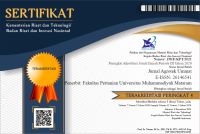Antioxidant activity using the cuprac method and determination of total phenolate content in the extract and fraction of macroalgae Eucheuma cottonii
Abstract
Keywords
Full Text:
PDF (Bahasa Indonesia)References
Alicic, R. Z., Rooney, M. T., & Tuttle, K. R. (2017). Diabetic kidney disease: Challenges, progress, and possibilities. Clinical Journal of the American Society of Nephrology, 12(12), 2032–2045. https://doi.org/10.2215/CJN.11491116
Apak, R., Güçlü, K., Özyürek, M., & Karademir, S. E. (2004). Novel total antioxidant capacity index for dietary polyphenols and vitamins C and E, using their cupric ion reducing capability in the presence of neocuproine: CUPRAC method. Journal of Agricultural and Food Chemistry, 52(26), 7970–7981. https://doi.org/10.1021/jf048741x
Farmakope Herbal Indonesia (II). (2017). Jakarta: Kementrian Kesehatan Republik Indonesia.
Fathmawati D, Abidin MRP, Roesyadi A. 2014. Studi Kinetika Pembentukan Karaginan Dari Rumput Laut. Jurnal Teknik Pomits. Vol 3(1): 27-32.
Forestryana, D., & Arnida, A. (2020). Skrining Fitokimia Dan Analisis Kromatografi Lapis Tipis Ekstrak Etanol Daun Jeruju (Hydrolea Spinosa L.). Jurnal Ilmiah Farmako Bahari, 11(2), 113. https://doi.org/10.52434/jfb.v11i2.859
Gusnedi, R. (2013). Analisis Nilai Absorbansi dalam Penentuan Kadar Flavonoid untuk Berbagai Jenis Daun Tanaman Obat. Pillar of Physics, 2, 76–83.
Hanapi A, Fasya AG, Mardiyah U, Miftahurrahmah. 2013. Aktivitas antioksidan dan antibakteri ekstrakm etanol alga merah Eucheuma spinosum dari perairan Wongsorejo Banyuwangi. Alchemy. Vol 2(2): 126-137.
Kurnia, Dewi., Suhardiman, Aris., Nurdiansyah, Hedy., Ghazhali, M., (2022) Antibacterial Activity Of Eucheuma Cottoni Extract And Fraction Against Acne-Causing Bacteria. Jurnal Agrotek UMMAT, 9(2), 88-94.
Maryam, S., Pratama, R., Effendi, N., & Naid, T. (2016). ANALISIS AKTIVITAS ANTIOKSIDAN EKSTRAK ETANOLIK DAUN YODIUM (Jatropha multifida L.) DENGAN METODE CUPRIC ION REDUCING ANTIOXIDANT CAPACITY (CUPRAC). Jurnal Fitofarmaka Indonesia, 2(1), 90–93. https://doi.org/10.33096/jffi.v2i1.185
Rasmussen, R. S., & Morrissey, M. T. (2007). Marine Biotechnology for Production of Food Ingredients. Advances in Food and Nutrition Research, 52(06), 237–292. https://doi.org/10.1016/S1043-4526(06)52005-4
Sedjati, S., Suryono, S., Santosa, A., Supriyantini, E., & Ridlo, A. (2017). Aktivitas Antioksidan dan Kandungan Senyawa Fenolik Makroalga Coklat Sargassum sp. Jurnal Kelautan Tropis, 20(2), 124. https://doi.org/10.14710/jkt.v20i2.1737
Sharo, N. M., Ningsih, R., Hanapi, A., & Nasichuddin, A. (2013). UJI TOKSISITAS DAN IDENTIFIKASI SENYAWA EKSTRAK ALGA MERAH (Eucheuma cottonii) TERHADAP LARVA UDANG Artemia salina LEACH. Alchemy, 2(3). https://doi.org/10.18860/al.v0i0.2892
Sridharan, M. C., & Dhamotharan, R. (2012). Antibacterial activity of marine brown alga Turbinaria conoides. Journal of Chemical and Pharmaceutical Research, 2012(4), 2292–2294.
Suryanto, E., & Wehantouw, F. (2009). Aktivitas Penangkap Radikal Bebas dari Ekstrak Fenolik Daun Sukun (Artocarpus altilis F.). Chemistry Progress, 2(1), 1–7.
Toga Nugraha, A. (2017). Profil Senyawa Dan Aktifitas Antioksidan Daun Yakon (Smallanthus Sonchifolius) Dengan Metode Dpph Dan Cuprac. Jurnal Ilmiah Farmasi, 13(1), 15–18. https://doi.org/10.20885/jif.vol13.iss1.art3
Yanuarti, R., Nurjanah, N., Anwar, E., & Hidayat, T. (2017). Profil Fenolik dan Aktivitas Antioksidan dari Ekstrak Rumput Laut Turbinaria conoides and Eucheuma cottonii. Jurnal Pengolahan Hasil Perikanan Indonesia, 20(2), 230.
DOI: https://doi.org/10.31764/jau.v9i4.11116
Refbacks
- There are currently no refbacks.
Copyright (c) 2022 Kurnia, Rohmah, & Anggraeni

This work is licensed under a Creative Commons Attribution-ShareAlike 4.0 International License.

 |  |  |  |
| |||
 |  |  |
|
POSTAL ADDRESS












